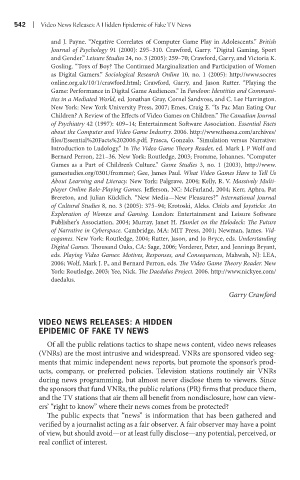Page 563 - Battleground The Media Volume 1 and 2
P. 563
| V deo News Releases: A H dden Ep dem c of Fake TV News
and J. Payne. “Negative Correlates of Computer Game Play in Adolescents.” British
Journal of Psychology 91 (2000): 295–310. Crawford, Garry. “Digital Gaming, Sport
and Gender.” Leisure Studies 24, no. 3 (2005): 259–70; Crawford, Garry, and Victoria K.
Gosling. “Toys of Boy? The Continued Marginalization and Participation of Women
as Digital Gamers.” Sociological Research Online 10, no. 1 (2005): http://www.socres
online.org.uk/10/1/crawford.html; Crawford, Garry, and Jason Rutter. “Playing the
Game: Performance in Digital Game Audiences.” In Fandom: Identities and Communi-
ties in a Mediated World, ed. Jonathan Gray, Cornel Sandvoss, and C. Lee Harrington.
New York: New York University Press, 2007; Emes, Craig E. “Is Pac Man Eating Our
Children? A Review of the Effects of Video Games on Children.” The Canadian Journal
of Psychiatry 42 (1997): 409–14; Entertainment Software Association. Essential Facts
about the Computer and Video Game Industry. 2006. http://www.theesa.com/archives/
files/Essential%20Facts%202006.pdf; Frasca, Gonzalo. “Simulation versus Narrative:
Introduction to Ludology.” In The Video Game Theory Reader, ed. Mark J. P Wolf and
Bernard Perron, 221–36. New York: Routledge, 2003; Fromme, Johannes. “Computer
Games as a Part of Children’s Culture.” Game Studies 3, no. 1 (2003), http://www.
gamestudies.org/0301/fromme/; Gee, James Paul. What Video Games Have to Tell Us
About Learning and Literacy. New York: Palgrave, 2004; Kelly, R. V. Massively Multi-
player Online Role-Playing Games. Jefferson, NC: McFarland, 2004; Kerr, Aphra, Pat
Brereton, and Julian Kücklich. “New Media—New Pleasures?” International Journal
of Cultural Studies 8, no. 3 (2005): 375–94; Krotoski, Aleks. Chicks and Joysticks: An
Exploration of Women and Gaming. London: Entertainment and Leisure Software
Publisher’s Association, 2004; Murray, Janet H. Hamlet on the Holodeck: The Future
of Narrative in Cyberspace. Cambridge, MA: MIT Press, 2001; Newman, James. Vid-
eogames. New York: Routledge, 2004; Rutter, Jason, and Jo Bryce, eds. Understanding
Digital Games. Thousand Oaks, CA: Sage, 2006; Vorderer, Peter, and Jennings Bryant,
eds. Playing Video Games: Motives, Responses, and Consequences, Mahwah, NJ: LEA,
2006; Wolf, Mark J. P., and Bernard Perron, eds. The Video Game Theory Reader. New
York: Routledge, 2003; Yee, Nick. The Daedalus Project. 2006. http://www.nickyee.com/
daedalus.
Garry Crawford
Video news releases: a hidden
ePideMiC oF Fake tV news
Of all the public relations tactics to shape news content, video news releases
(VNRs) are the most intrusive and widespread. VNRs are sponsored video seg-
ments that mimic independent news reports, but promote the sponsor’s prod-
ucts, company, or preferred policies. Television stations routinely air VNRs
during news programming, but almost never disclose them to viewers. Since
the sponsors that fund VNRs, the public relations (PR) firms that produce them,
and the TV stations that air them all benefit from nondisclosure, how can view-
ers’ “right to know” where their news comes from be protected?
The public expects that “news” is information that has been gathered and
verified by a journalist acting as a fair observer. A fair observer may have a point
of view, but should avoid—or at least fully disclose—any potential, perceived, or
real conflict of interest.

